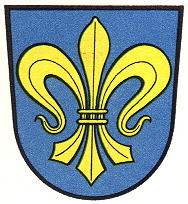Löhnberg: Difference between revisions
Knorrepoes (talk | contribs) m (Text replacement - "|Wappen von {{PAGENAME}}]] ====Official blazon==== " to "|Wappen von {{PAGENAME}}]] ===Official blazon=== ") |
Knorrepoes (talk | contribs) m (Text replacement - "====Origin/meaning====" to "===Origin/meaning===") |
||
| Line 10: | Line 10: | ||
In Blau eine goldene Lilie. | In Blau eine goldene Lilie. | ||
===Origin/meaning=== | |||
Löhnberg received city rights in 1321, the oldest seal, however, is known from 1492 and shows the fleur-de-lis with the letters LO. The fleur-de-lis is a symbol for justice, the letters are the initials of the city. In 1816 the fleur-de-lis was replaced by an image of the local castle, which burned down in 1900. The image of the castle was still used as arms on a decoration in the city hall in 1905. | Löhnberg received city rights in 1321, the oldest seal, however, is known from 1492 and shows the fleur-de-lis with the letters LO. The fleur-de-lis is a symbol for justice, the letters are the initials of the city. In 1816 the fleur-de-lis was replaced by an image of the local castle, which burned down in 1900. The image of the castle was still used as arms on a decoration in the city hall in 1905. | ||
Revision as of 19:17, 22 June 2017
This page is part of the German heraldry portal |
Heraldry of the World |
|
German heraldry:
|
Selected collector's items from Germany:
|
LÖHNBERG
State : Hessen
District (Kreis) : Limburg-Weilburg (until 1975 Oberlahnkreis)
Official blazon
In Blau eine goldene Lilie.
Origin/meaning
Löhnberg received city rights in 1321, the oldest seal, however, is known from 1492 and shows the fleur-de-lis with the letters LO. The fleur-de-lis is a symbol for justice, the letters are the initials of the city. In 1816 the fleur-de-lis was replaced by an image of the local castle, which burned down in 1900. The image of the castle was still used as arms on a decoration in the city hall in 1905.
The above arms were granted in 1938 and are based on the oldest seal. The letters were omitted. The colours were derived from the arms of the Nassau family, as the area was already part of the County of Nassau in 1179.
Contact and Support
Partners:
Your logo here ?
Contact us
© since 1995, Heraldry of the World, Ralf Hartemink 
Index of the site
Literature : Stadler, K. : Deutsche Wappen - Bundesrepublik Deutschland. Angelsachsen Verlag, 1964-1971, 8 volumes.












